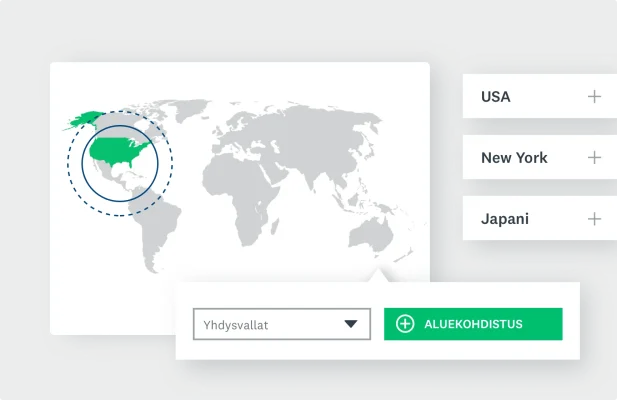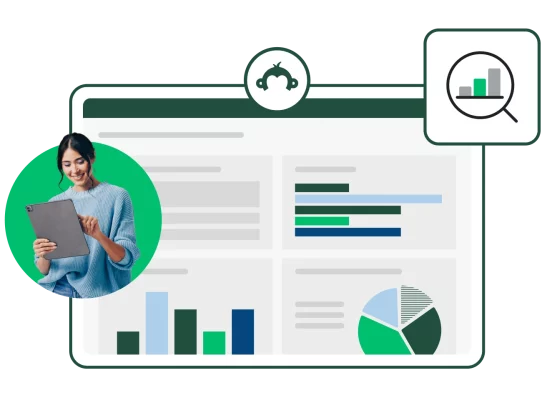Markkinasegmentoinnin viisi tyyppiä sekä niiden käyttötavat ja esimerkkejä

- Markkinasegmentoinnissa laajat kuluttajamarkkinat jaetaan pienemmiksi ryhmiksi yhteisten ominaisuuksien mukaan.
- Markkinasegmentointi on tärkeää, sillä se auttaa yrityksiä kohdentamaan tarjonnan tehokkaasti asiakkaille ja parantaa siten asiakastyytyväisyyttä ja yrityksen toimintaa.
- Tässä esiteltävät markkinasegmentoinnin viisi tyyppiä ovat demografinen, psykografinen, käyttäytymiseen perustuva, maantieteellinen ja firmografinen segmentointi.
Asiakaskunta on muuttuva kokonaisuus, jonka kaikki ainutlaatuiset osat punoutuvat yhteen. Markkinasegmentoinnin tehtävä on tunnistaa kuviot, ryhmitellä asiakkaat yhteisten piirteiden perusteella ja luoda yhteisiin tarpeisiin ja mielihaluihin vetoavia strategioita.
Luotuaan ryhmiä markkinoita segmentoimalla yritykset voivat mainostaa niille aiempaa tehokkaammin, sillä tietyt mieltymykset voivat erottaa segmentit toisistaan. Kun yritykset keskittyvät kunkin ryhmän toivomuksiin, ne voivat lujittaa sitoutumista, lisätä vuorovaikutusta ja edistää myyntiä.
Mitä markkinasegmentointi tarkoittaa?
Markkinasegmentoinnissa laaja yleisö jaetaan alaryhmiin tiettyjen yhteisten seikkojen perusteella. Ryhmän jäseniä saattavat yhdistää demografiset tiedot (kuten ikä tai sukupuoli), maantieteellinen sijainti, asenteet, käyttäytymismallit tai vastaavien ominaisuuksien yhdistelmät.
Kun jaamme kohdeyleisön pienempiin ryhmiin niiden yhteisten tekijöiden perusteella, osaamme kohdentaa markkinointitoimia tehokkaammin.
Tunnetko kohdemarkkinoidesi piirteet?
Selvitä asia muutamassa minuutissa SurveyMonkeyn kuluttajasegmentoinnin avulla.
Miksi markkinasegmentointia kannattaa käyttää?
Markkinasegmentoinnin ansiosta yritykset voivat luoda tarkkoja profiileja kustakin markkinasegmentistä. Markkinoijat voivat näiden tarkkojen segmenttien ansiosta luoda strategioita, jotka maksimoivat tuotteiden ja palveluiden myynnin.
Tämän tavoitteen saavuttamiseksi markkinoijien käyttämässä kolmivaiheisessa prosessissa selvitetään, keistä kohdeyleisö koostuu ja miksi he ostavat tuotteita.
- Segmentointi: markkinoijat jakavat markkinat luokkiin yhteisten ominaisuuksien perusteella.
- Kohdennus: markkinoijat valitsevat markkinoiden osa-alueen tai kohderyhmän, joka todennäköisimmin ostaa yrityksen tuotteita.
- Asemointi: markkinoijat tutkivat, mikä tuotteen, hinnan, mainonnan ja sijainnin yhdistelmä houkuttelee asiakkaita tuotteen ostajiksi.
Kohdeyleisön määrittämisen jälkeen on selvitettävä, mikä erottaa tuotteen muista vastaavista. Onko se muita parempi, nopeampi, halvempi tai edistyksellisempi? Tässä on avuksi markkinoijien käsitys kohdeyleisön ongelmista ja luovien ratkaisujen mahdollisuuksista.
Yrityksille muista erottuminen on kilpailuetu, kun ne ratkaisevat ainutlaatuisilla tuotteillaan ja palveluillaan asiakkaiden ongelmat.
Määrittämällä kohdemarkkinat, selvittämällä niiden ongelmat ja luomalla ongelmia ratkaisevia tuotteita markkinoijat todennäköisesti menestyvät kilpailijoitaan paremmin.
Esimerkkejä markkinasegmentoinnista
Markkinasegmentointi on onnistuneen tuotemarkkinoinnin ensimmäinen vaihe. Niin kuluttajille kuin yrityksille markkinoivat yritykset hyötyvät markkinasegmentoinnista, sillä se auttaa yrityksiä ymmärtämään paremmin asiakkaidensa ongelmia sekä ratkaisemaan ne.
Kaikki yritykset eivät segmentoi asiakkaitaan samalla tavalla, vaan ne saattavat käyttää erilaisia menetelmiä.
Tässä on kolme tyypillistä esimerkkiä markkinasegmentoinnista.
Ei segmentointia
Yritykset saattavat massamarkkinoida tuotteitaan kaikille ilman sen kummempia strategioita. Esimerkiksi suolaa tai muita yleisiä hyödykkeitä myyvät yritykset eivät juurikaan käytä voimavaroja markkinoiden segmentointiin.
Rajallinen segmentointi
Yritykset saattavat käyttää yhtä tai useampaa tarkkaan rajattua kohdemarkkinaa luodakseen erittäin kohdistetun markkinaraon erikoistuotteille. Näin myydään esimerkiksi kalliita muotivaatteita, käsintehtyä taidetta tai koneisiin mittatilauksena tehtyjä osia.
Tuhansia segmenttejä
Hypersegmentoinnissa markkinoijat voivat yksilöidä kohdistetun markkinointitavan kullekin asiakkaalle pitkäaikaisten suhteiden luomiseksi. Esimerkiksi kampaamoiden kaltaiset yksilöitävät palvelut ja Amazonin kaltaiset verkkokaupat tarjoavat yksilöllisiä suosituksia ostohistorian perusteella.
Markkinasegmentoinnin viisi tyyppiä
Segmenttien määrästä riippumatta yrityksesi kannattaa olla tietoinen viidestä erilaisesta markkinasegmentoinnin tyypistä.
Tutustumme nyt demografiseen, psykografiseen, käyttäytymiseen perustuvaan, maantieteelliseen ja firmografiseen segmentointiin sekä niiden käyttötapoihin.
1. Demografinen segmentointi
Demografisessa segmentoinnissa oletetaan, että samankaltaiset demografiset ominaisuudet jakavilla ihmisillä on samankaltaiset elämäntyylit, mieltymykset ja kiinnostuksen kohteet, jotka vaikuttavat heidän ostokäyttäytymiseensä. Demografiset tiedot yhdistetään usein muihin segmentointitapoihin, jotta esille saadaan tuotteita todennäköisimmin ostavat kohdemarkkinat.
Demografisiin tietoihin lukeutuvat esimerkiksi ikä, sukupuoli, ammatti sekä tulo- ja koulutustaso.
Näin hyödynnät demografista segmentointia
Demografisen segmentoinnin etu on se, että demografiset tiedot ovat helposti saatavilla. Viralliset lähteet, kuten Bureau of Labor Statistics Yhdysvalloissa, voivat tarjota kotitalouksia, tulotasoja, koulutusta ja terveyttä koskevia tietoja markkinointistrategian ja liiketoiminnan tavoitteita varten.
Markkinoijat voivat käyttää demografisia tietoja niin markkinasegmentointiin kuin asiakassegmentointiin. Demografisia ja käyttäytymiseen perustuvia tietoja hyödyntämällä markkinoijat voivat selvittää:
- tuotteen mahdollisuudet markkinoilla
- brändin vertautumisen kilpailijoihin
- mitkä demografiset ryhmät todennäköisesti ostavat yrityksen tuotetta tai palvelua
- mitkä kampanjat vetoavat parhaiten kohdemarkkinoihin.
Käyttäytymismalleihin ja muihin muuttujiin yhdistettynä demografisesta segmentoinnista saatavilla arvokkailla havainnoilla voidaan selvittää, ketkä kohdemarkkinoiden asiakkaat ostavat yrityksen tuotteita, sekä ymmärtää paremmin, miten heidät voidaan tavoittaa juuri oikeanlaisella markkinointiviestinnällä.
2. Psykografinen segmentointi
Psykografisessa segmentoinnissa ihmiset jaetaan ryhmiin persoonallisuuden, elämäntyylin, sosiaalisen statuksen, toiminnan, kiinnostuksen kohteiden, mielipiteiden ja asenteiden mukaan. Psykografiset tiedot täydentävät mainiosti demografisia tietoja, sillä niiden avulla tunnistetaan ihmisten valintoja ohjaavat vaikuttimet.
Oletko pähkäillyt kohdemarkkinoidesi demografisia tietoja viime aikoina?
Muutos on nopeaa. Keskity oleelliseen SurveyMonkeyn kuluttajasegmentoinnin avulla.
Näin hyödynnät psykografista segmentointia
Psykografisessa segmentoinnissa saadaan tehokkaasti selville asiakkaiden ongelmat, käyttäytymismallit ja asenteet.
Yritykset käyttävät psykografisia tietoja markkinasegmentoinnissa selvittääkseen:
- kuluttajien käsitykset tuotteista ja palveluista
- kuluttajien todelliset toiveet ja niiden syyt
- nykyisten tuotteiden tai palveluiden puutteet tai kipukohdat
- tulevat sitouttamismahdollisuudet
- kuinka kohdeyleisölle suunnattua viestintää voidaan parantaa.
3. Käyttäytymiseen perustuva segmentointi
Käyttäytymiseen perustuvassa markkinasegmentoinnissa kuvaillaan tiettyjä vaiheita ihanneasiakkaan ostoprosessissa, kuten mitä nämä asiakkaat haluavat ja miksi, millaisia etuja he kaipaavat ja millä tavoin he saavat tarpeensa täytetyiksi.
Näin hyödynnät käyttäytymiseen perustuvaa segmentointia
Käyttäytymiseen perustuvaa segmentointia käytetään sekä kuluttaja- että yritysmarkkinasegmenttien tutkimisessa: kun yritykset ymmärtävät, miksi ihmiset ostavat, ne pystyvät kohdistamaan markkinointiviestintänsä paremmin. Esimerkkejä ostokäyttäytymisen osa-alueista:
- Ostoksen tekemisen syy: etsivätkö ostajat edullisinta hintaa, loistavia arvosteluja, turvallisuusominaisuuksia vai jotain muuta?
- Tilaisuus tai tapahtuma: ostavatko kuluttajat lomaa vai hääpäivää varten tai yrittävätkö yritysasiakkaat käyttää budjettinsa ennen vuoden loppua?
- Tuote-edut: onko ostaja etsimässä uusinta teknologiaa, turvallisinta tuotetta vai haluaako hän käsiinsä tuoreimman uutuuden ensimmäisenä?
- Brändituntemuksen taso: haaliiko ostaja alustavia tietoja tulevaa ostosta varten vai onko hän tutustumassa brändiin ensimmäistä kertaa?
- Sitoutumisen taso: onko kuluttaja yrityksen suurin fani, joka haluaa ostaa sen upouuden tuotteen?
Kun markkinoijat tietävät, miksi kuluttajat tai yritykset haluavat ostaa yrityksen tuotteita, he voivat hyödyntää tietoa ostokäyttäytymisestä segmentointistrategiassaan.
4. Maantieteellinen segmentointi
Maantieteellisessä segmentoinnissa markkinoijat voivat ryhmitellä ihmisiä sen mukaan, missä nämä asuvat, työskentelevät tai matkailevat.
Sijainti vaikuttaa merkittävästi ostotottumuksiin. Markkinoijat voivat hyödyntää sitä markkinointiviestinnän kehittämisessä käyttämällä muuttujina esimerkiksi maata, aluetta, maakuntaa, paikkakuntaa, ilmastovyöhykettä tai postinumeroa.
Kulttuuri ja väestöntiheys (niin kaupungissa kuin maaseudulla) ovat myös tärkeitä muuttujia markkinatutkimuksessa, sillä ne vaikuttavat ihmisten ongelmiin kyseisellä alueella ja markkinoijien keinoihin ratkaista ne.

Näin hyödynnät maantieteellistä segmentointia
Asuinpaikka voi vaikuttaa kaikenlaisiin asioihin aterioista ajoneuvoihin. Yritykset voivat maantieteellisen segmentoinnin perusteella päättää, mitä tuotteita asiakkaille kannattaa myydä.
Esimerkki maantieteellisestä segmentoinnista on kasvien markkinointi ilmastovyöhykkeen perusteella: pelargonit soveltuvat parhaiten lämpimiin ja aurinkoisiin paikkoihin, kun taas lumiangervo viihtyy kylmissäkin olosuhteissa. Maantieteellisen alueen tunteminen auttaa markkinoijia selvittämään, millä kasveilla, multalajeilla ja puutarhavälineillä on eniten kysyntää missäkin ilmastossa.
Vaateyritys puolestaan voisi suositella takkeja kylmien ilmastojen asukkaille. Tuotemainonnan mukauttaminen sijainnin perusteella voi vaikuttaa voimakkaasti siihen, kuinka paljon ostoksen tekemistä harkitaan.
Lisäluettavaa: Kattava opas segmentointikyselytutkimusten tekemiseen
5. Firmografinen segmentointi
Firmografinen segmentointi on yritysmarkkinoijille yhtä tärkeää kuin demografinen segmentointi kuluttajamarkkinoijille. Firmografia kattaa esimerkiksi yrityksen kohdemarkkinoiden piirteet, toimialan, työntekijöiden lukumäärän, oikeudellisen statuksen, yrityksen koon ja taloudellisen tilanteen.
Miljoonat ihmiset muuttavat vuosittain. Ovatko kohdemarkkinoidesi maantieteelliset profiilit muuttuneet? Selvitä asia muutamassa tunnissa SurveyMonkeyn kuluttajasegmentoinnin avulla.
Näin hyödynnät firmografista segmentointia
Firmografiset tiedot kertovat markkinoijille kohdemarkkinoiden yritysten vahvuuksista ja elinvoimaisuudesta. Taloudellisen tuloksen ja kasvutrendien perusteella voidaan päätellä, onko markkinasegmentti menossa kasvu- vai laskusuuntaan.
Esimerkkejä firmografisesta datasta:
- Toimialaluokitus: Suomen kansallinen toimialaluokitus (TOL 2025).
- Omistajuus ja oikeudellinen status: omistussuhteet, mukaan lukien itsenäiset ammatinharjoittajat, osakeyhtiöt, kommandiittiyhtiöt ja pörssiyhtiöt.
- Toimintavuodet: toiminnan pituus voi merkitä taloudellista vakautta ja kokemusta toimialalta.
- Työntekijöiden lukumäärä: työntekijöiden lukumäärä kertoo, miten suuri yritys on.
- Sijainti: sijaintiin lukeutuvat toimistot, tehtaat ja myymälät.
- Asiakkaat ja tuotteet: yrityksen valmistamat tai myymät tuotteet sekä yrityksen kohdeyleisö.
- Markkinaosuus: yrityksen markkinoiden koko ja yrityksen kilpailijat.
Markkinasegmentoinnin edut

Markkinasegmentointi on onnistuneiden tuotekonseptien, lanseerausten, markkinointiviestien, mainonnan ja muiden tärkeiden markkinointitoimintojen peruspilari.
Yritykset investoivat tärkeitä voimavaroja ymmärtääkseen asiakkaiden ongelmat ja ratkaistakseen ne asiakkaiden arvostamilla tuotteilla ja palveluilla. Kuinka yritykset sitten hyötyvät käytettyään aikaa ja vaivaa markkinasegmentointiin?
Mainoskampanjoiden laatu paranee
Yritykset käyttävät miljardeja euroja markkinointiin ja mainontaan, kun ne tietävät tarkkaan, ketkä kuuluvat niiden kohdeyleisöihin ja mitä asiakkaat haluavat. Markkinoijat keräävät valtavia määriä dataa kohdeyleisöistään varmistaakseen, että tuotteiden markkinointiviestit miellyttävät oikeita asiakkaita oikeaan aikaan.
Kyselytutkimukset ovat erinomainen tapa testata markkinointiviestintää sen varmistamiseksi, että viestintä vetoaa kohdeyleisöön. Prosessi käynnistetään luomalla hypoteesi siitä, miten kyselytutkimusten vastaajien odotetaan reagoivan. Kyselytutkimustulokset auttavat sitten luomaan parempaa viestintää ja onnistuneempia kampanjoita.
Kehitä täsmätuotteita
Yrityksillä on loistavia uusia tuoteideoita, mutta niiden on selvitettävä, ratkaisevatko kyseiset ideat kohdemarkkinoiden kokeman ongelman. Ilman markkinasegmentointia yritykset tuhlaavat aikaa ja vaivaa tuotteeseen, joka kuulostaa hyvältä mutta ei mene kaupaksi.
Kyselytutkimukset auttavat mittaamaan kohdemarkkinoita, ja yritykset voivat muutamassa tunnissa selvittää:
- ratkaiseeko tuote kohdemarkkinoiden ongelmakohdan
- mitkä ideat voivat menestyä
- onko tuotekonseptissa oikeat ominaisuudet, pakkaus ja logo
- ostetaanko tuotetta ja mihin hintaan.
Kun yritykset saavat oikeat vastaukset tarkoin määritetyltä kohdeyleisöltä, ne voivat keskittyä menestystuotteisiin, joita kohdeyleisö haluaa ostaa.
SurveyMonkeyn konseptien testausratkaisu osoittaa, onko uudessa tuoteideassa ytyä. Saat tuotteen suoriutumisesta kertovan tuloskortin, jossa on myös toimialan vertailuarvoja.
Uusien suuntausten ja mahdollisuuksien havaitseminen
Trendit muuttuvat nopeasti. Sosiaalinen media voi tuoda esiin asiakkaiden käyttäytymismalleja, mutta markkinoijat eivät tiedä, kannattaako mahdollisuuksiin tarttua, ellei käyttäytymismalleja mitata.
Kohdemarkkinoiden käyttäytymisen ymmärtäminen on markkinasegmentoinnin keskiössä. Uusien trendien ilmaantuessa markkinoijien tehtävä on selvittää, mitkä niistä ovat uusia mahdollisuuksia ja mitkä niistä menettävät suosionsa nopeasti.
Markkinoijat ovat vastuussa asiakkaiden uusien ongelmien tunnistamisesta, uusien markkinointiviestien luomisesta ja uusien tuotekonseptien testaamisesta. Uusia mahdollisuuksia löytääkseen markkinoijien on usein pyydettävä kohdeyleisön mielipiteitä ja varmistettava, että asiakkaat pitävät edelleen aiemmin lanseeratuista tuotteista.
Panostus liiketoimintaan
Markkinasegmentoinnissa käytetään luotettavaa datajoukkoa, jonka sisältämiä asiakastietoja voidaan käyttää yrityksen menestymisen edistämiseen myös muilla osastoilla. Yritysten välistä kauppaa harjoittavissa yrityksissä markkinointi- ja myyntiosastot toimivat tavallisesti tiiviissä yhteistyössä, sillä myynti on riippuvainen markkinoinnin kyvystä tarjota laadukkaita liidejä, jotka edistävät liikevaihdon kasvua.
Myös tuotteiden hinnoittelusta vastaava osasto tarvitsee tietoa markkinoista ja kilpailijoista voidakseen määrittää tuotteille oikean hinnan, mikä auttaa kilpailukyvyn säilyttämisessä. Tämän lisäksi mikään tuotanto-osasto ei halua tehdä varoittamatta ylitöitä, koska yhtäkkiä kysyntään vastaamiseksi tarvitaankin tuplasti tuotteita. Kun ostotrendeistä ja kysynnästä tiedotetaan etukäteen, tuotanto pysyy ajan tasalla.
Markkinasegmentoinnin dataa ei ole tarkoitettu ainoastaan markkinointiosaston käyttöön, vaan sitä on jaettava, jotta koko yritys voi palvella asiakkaitaan.
Brändiluottamuksen vakiinnuttaminen
Yritykset haluavat tehdä muutakin kuin vain myydä tuotteita kohdeyleisölleen: ne haluavat luoda suhteita asiakkaisiinsa, jotta nämä jatkaisivat tuotteiden ostamista. Kun asiakkaat sekä tuntevat yrityksen tuotteet että pitävät niistä ja ostavat niitä, yritys on onnistunut luomaan luottamusta brändiin.
Markkinasegmentoinnissa selvitetään, mikä yleisö todennäköisimmin ostaa useammin kuin kerran. Kun yritykset luovat asiakkaiden arvostaman brändi-identiteetin, ne voivat alkaa lisätä bränditietoisuutta ja luoda luottamuksellisen suhteen kohdemarkkinoihinsa. Kun yritykset keskittyvät tämän luottamuksen ylläpitämiseen, ne luovat markkinointiviestintää, uusia tuotteita, arvokasta sisältöä, ajantasaista tietoa ja asiakaskokemuksia, jotka saavat niin kuluttaja- kuin yritysasiakkaat ostamaan tuotteita yhä uudestaan.
Kohdemarkkinoiden segmentointi auttaa markkinoijia ymmärtämään asiakkaidensa ongelmia ja käyttäytymistä sekä tarjoamaan ratkaisuja, jotka lisäävät luottamusta brändiin molempia osapuolia hyödyttävällä tavalla.
Millainen suhde sinulla on yleisöösi?
Selvitä SurveyMonkeyn brändin seurannan avulla, miten luottamus brändiin luodaan.
Segmentoi datasi SurveyMonkeyssa
Kun yrityksillä on käsitys markkinasegmentoinnista, ne voivat luoda kaikkia miellyttävää, kiinnostavaa ja yksilöllistä sisältöä. Yleisön segmentointi on tärkeää, jotta voidaan luoda tehokasta markkinointimateriaalia ja lujittaa asiakkaiden sitoutumista.
Lue lisää datan segmentoinnista SurveyMonkeyssa ja miten luodaan yksityiskohtaisia asiakasryhmiä ja tehokasta viestintää. Rekisteröidy jo tänään, niin voit aloittaa asiakassegmentoinnin.
Aloita markkinatutkimus
Maailmanlaajuinen kyselytutkimuspaneeli
Kerää markkinatutkimusdataa lähettämällä kyselytutkimuksesi edustavalle otokselle.
Asiantuntijaratkaisut
Testaa luovia konsepteja tai tuotekonsepteja käyttämällä automatisoitua analysointia ja raportointia.
